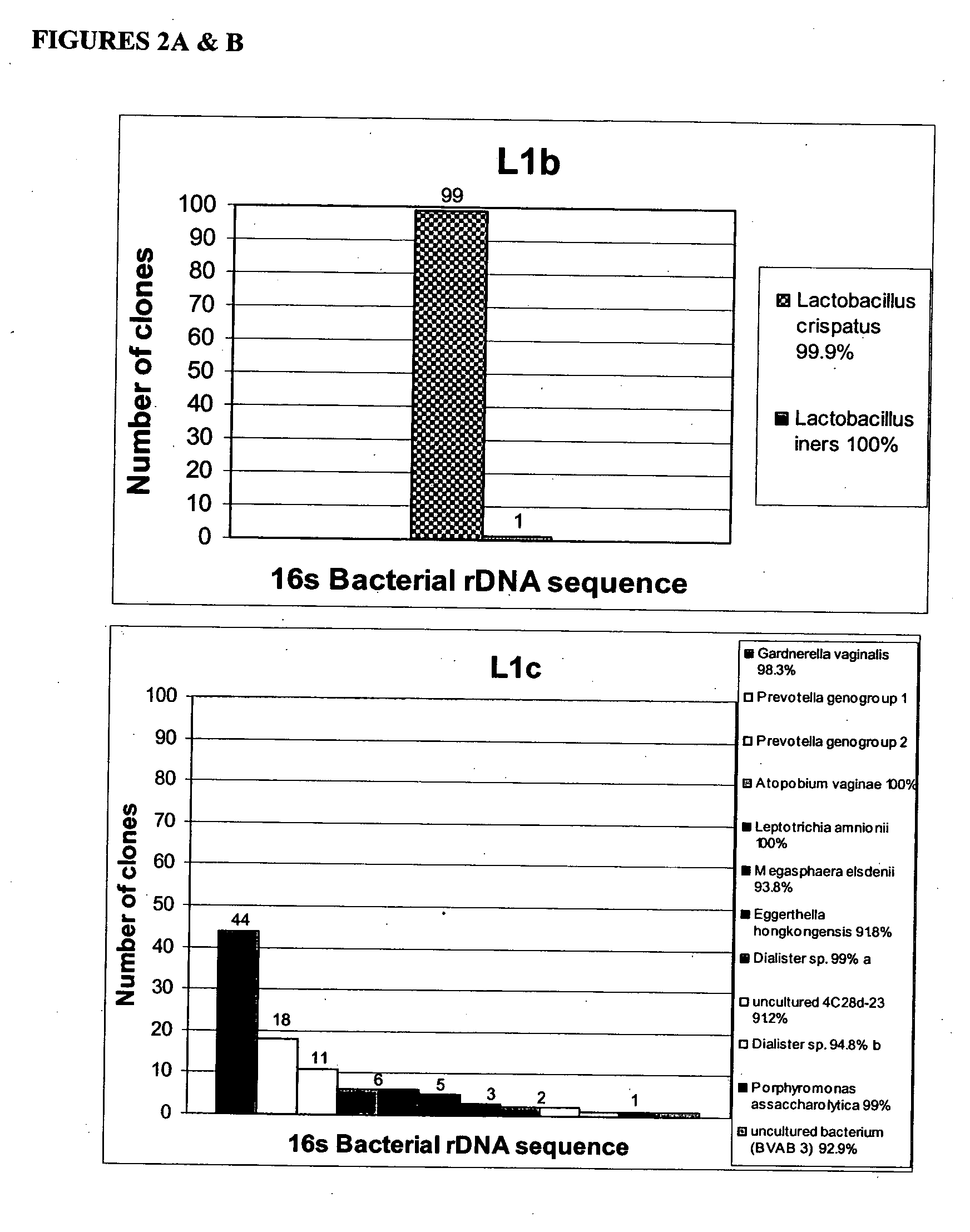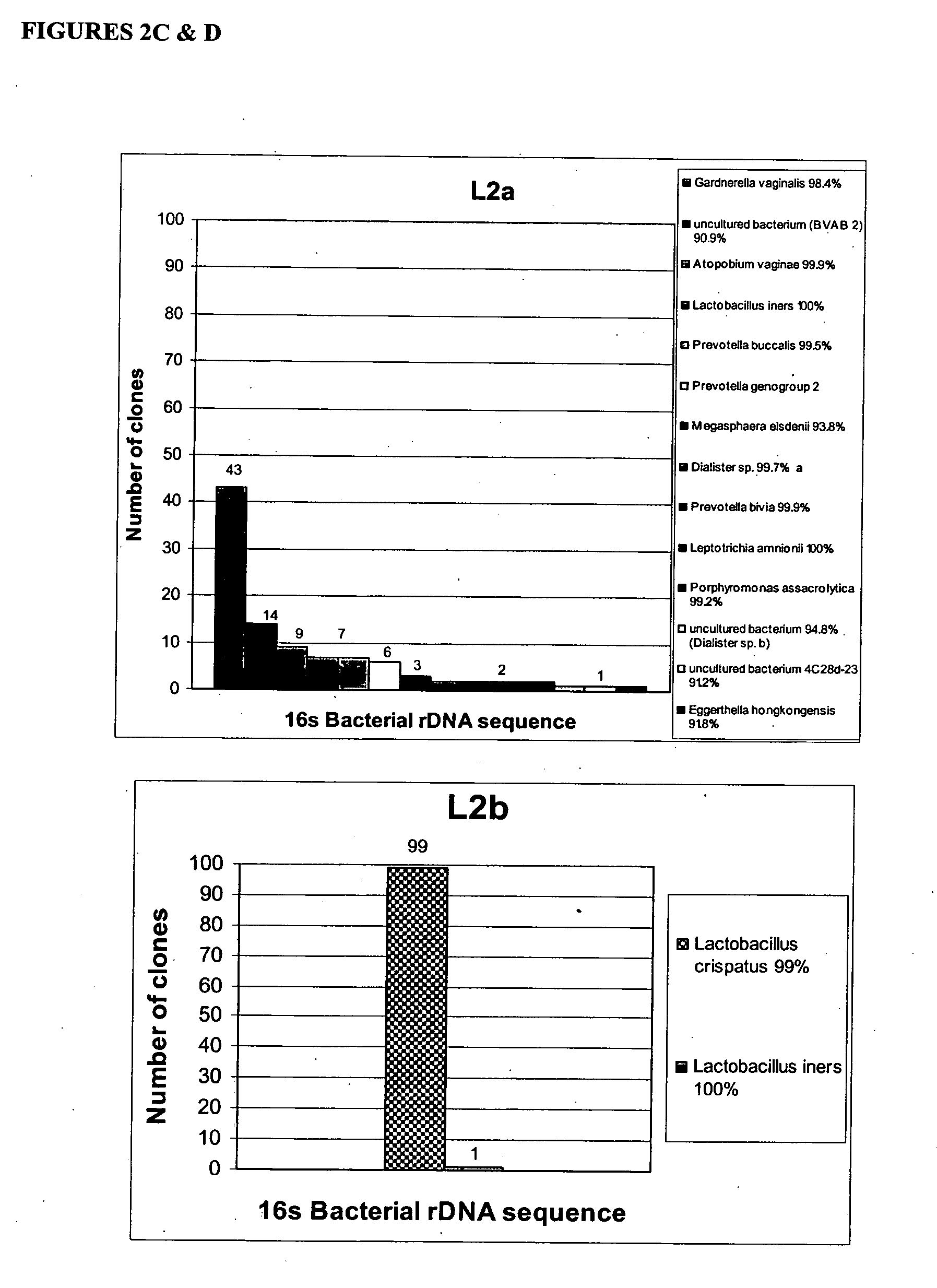Methods and compositions for identifying bacteria associated with bacterial vaginosis
a technology of vaginosis and composition, applied in the field of identification of bacteria associated with bacterial vaginosis, can solve the problems of poor in vitro activity of metronidazole against i>g. vaginalis/i>and i>m. curtisii/i>, and the cultivation of bacteria in vaginal fluid has not proved useful for the diagnosis of bv
- Summary
- Abstract
- Description
- Claims
- Application Information
AI Technical Summary
Benefits of technology
Problems solved by technology
Method used
Image
Examples
example 1
[0185] Study population: The first 73 women enrolled were studied out of a total of 87 women recruited from two groups known to have high BV prevalence17-20: sexually transmitted disease (STD) clinic clients (Public Health, Seattle & King County STD Clinic (14 subjects)) and women who reported same sex behavior in the previous year, most of whom were also sexually active with male partners (Harborview Women's Research Clinic (WRC) (59 subjects)). Women were eligible if they were 16 to 45 years old and able to provide written informed consent. Single baseline vaginal fluid samples from the 73 subjects were studied using bacterium specific 16S rDNA PCR, including 27 subjects with BV as defined by Amsel clinical criteria12 and 46 subjects without BV. Vaginal fluid samples from 21 of these 73 subjects were studied using broad range bacterial 16S rDNA PCR with clone analysis, including single baseline samples from 9 subjects with BV and 8 subjects without BV, and multiple follow-up sampl...
example 2
[0200] Bacterium-specific PCR results, 264 sample analysis. PCR primers were designed to anneal to species-specific regions of the bacterial 16S rRNA gene (16S rDNA). These novel primers were used in PCR assays capable of detecting 1-100 molecules of cloned 16S rDNA from each bacterium. When amplicons of the correct size were seen on ethidium bromide stained agarose gels, the PCR products were sequenced to confirm identity with the expected bacterial target. Several bacterial species were very sensitive and specific indicators of BV when PCR detection in vaginal fluid was used as the diagnostic test.
[0201] Samples from 216 patients at the Women's Research Clinic (WRC) were analyzed according to the Amsel clinical criteria (Table 6) and the Nugent criteria (Table 7). Amsel criteria include the presence of at least 3 of 4 clinical elements, (1) thin, homogeneous, milky, vaginal discharge; (2) vaginal fluid pH greater than 4.5; (3) positive whiff test—production of fishy odor when 10%...
example 3
[0206] Quantitative real time PCR. Vaginal fluid DNA extracted from swabs was added to PCR reactions containing master mix, primers (Table 10), a TaqMan® probe (dual labeled probe for detection with 5′-exonuclease based hydrolysis), and a thermally stable DNA polymerase. Other approaches for real time or endpoint detection of PCR products, such as the use of fluorescence resonance energy transfer (FRET) probes (see, e.g., Loeffler et al. “Quantification of fungal DNA by using fluorescence resonance energy transfer and the light cycler system”J. Clin. Microbiol. 38:586-590 (2000)), are also possible using these reagents.
[0207] In these experiments, the detection threshold for each assay was assessed using a dilution series of purified plasmids containing bacterial 16S rDNA sequences from specific bacterial species (Table 12) of known concentrations. A standard curve was generated for each assay using a plasmid of cloned 16S rDNA from the appropriate vaginal bacterium, thus assay res...
PUM
| Property | Measurement | Unit |
|---|---|---|
| Capacitance | aaaaa | aaaaa |
| Temperature | aaaaa | aaaaa |
| Temperature | aaaaa | aaaaa |
Abstract
Description
Claims
Application Information
 Login to View More
Login to View More - R&D
- Intellectual Property
- Life Sciences
- Materials
- Tech Scout
- Unparalleled Data Quality
- Higher Quality Content
- 60% Fewer Hallucinations
Browse by: Latest US Patents, China's latest patents, Technical Efficacy Thesaurus, Application Domain, Technology Topic, Popular Technical Reports.
© 2025 PatSnap. All rights reserved.Legal|Privacy policy|Modern Slavery Act Transparency Statement|Sitemap|About US| Contact US: help@patsnap.com



